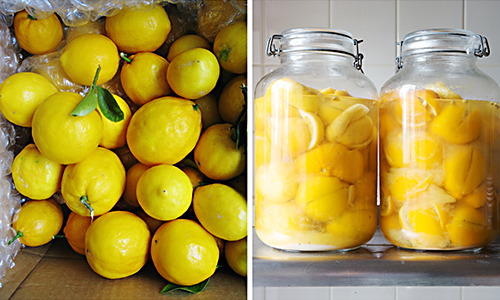Lunch for the creative crew
from Williams–Sonoma
Spring Sorrel Soup
Poached Wild Salmon with a “Sauce” of Peas, Bacon, and Chives
Young Leaves, Fresh Herbs, and Wild Violets with Lemon and Olive Oil
A Very Ripe French Brie and Crunchy Bread
Strong Coffee and Cookies
The other day the creative crew from Williams-Sonoma came for lunch. It was a beautiful sunny spring day with a blue sky full of big puffy clouds. Thank heavens there was still enough of a chill in the air so we could justify building a fire in the wood-burning stove—a fire always seems to cheer and cozy the whole place up. So we had the best of both seasons that day.
We made a special lunch in their honor and had a wonderful time before they had to run off and jump on a plane back to San Francisco. We talked about all kinds of things but they must have really been listening when we spoke of our love of Meyer lemons. They told us of lemon trees laden with fruit right in their backyards—Oh California! A few days later a big bulging box arrived at the studio. They had picked a pile of Meyer lemons from their trees and sent the mother lode to us as a thank you present for lunch. Now that was the Thank You “Note” of all times in our book.
Here’s how we preserved the lemons and along with them the memory of the day and their lovely gift.
PRESERVED LEMONS
Everyone needs a few culinary tricks up their sleeve—or, better yet, in their refrigerator. If you live in a metropolitan area with lots of ethnic shops, you’ll be able to find these lemons already cured. Living far from those stores, we make our own—big jars of them that last us throughout the year. And it is so well worth it. These golden treasures are money in the bank as their deep salty-sour flavor can brighten up practically any dish. Actually, we have to restrain ourselves from using them in just about everything.
We like to use Meyer lemons, a sweet, thin-skinned variety (most likely a cross between a mandarin orange and a true lemon). You’ll find them in the market from fall through spring. But any variety of lemon will do. In fact, a thicker-skinned lemon is the traditional choice in Morocco, where this pickling method originated.
Preserved lemons are typically rinsed before they are added to stews, tagines, soups, and couscous dishes. Only the rind is used and the pulpy flesh gets discarded. When our own preserved lemons are still new (aged between one month and about six months), we use both rind and flesh, not even bothering to rinse the lemons. The salty brine softens the rind until it is almost translucent and makes the flesh plump and supple. The longer the lemons cure, the saltier they get, so taste them first to decide how you will cook with them. Preserved lemons will last up to 1 year in the fridge.
Lemons, washed
Kosher salt
Sterilized wide-mouth container with a tight-fitting lid
Cut the lemons (almost all the way through) into quarters, keeping them attached at the stem end. Working over a bowl, tamp the inside of each lemon with salt. Tightly pack the salt-filled lemons into the sterilized container. Pour more salt over the lemons as you fill the container. Cover the salt-packed lemons with freshly squeezed lemon juice.
Store in the refrigerator. Turn the container occasionally for the first few weeks to moisten all the lemons with the ever-accumulating salty brine. The lemons should eventually become submerged in this brine. If the brine doesn’t completely cover them after a month, use a metal kitchen spoon to gently press the lemons under the surface.
Recipe from Canal House Cooking, Volume N° 1

